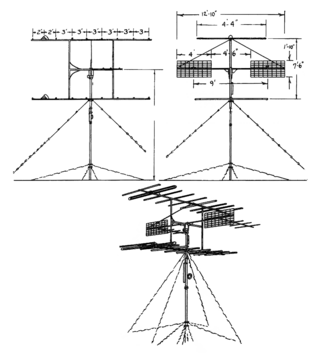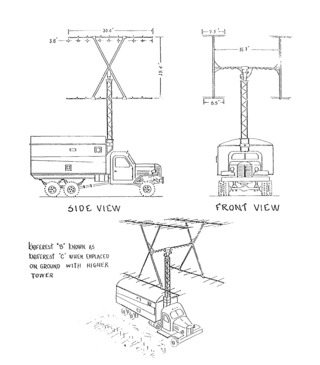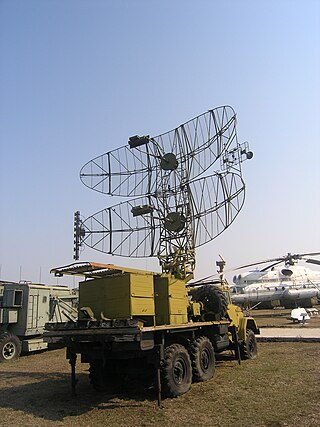
Radar is a radiolocation system that uses radio waves to determine the distance (ranging), angle (azimuth), and radial velocity of objects relative to the site. It is used to detect and track aircraft, ships, spacecraft, guided missiles, motor vehicles, map weather formations, and terrain. A radar system consists of a transmitter producing electromagnetic waves in the radio or microwaves domain, a transmitting antenna, a receiving antenna and a receiver and processor to determine properties of the objects. Radio waves from the transmitter reflect off the objects and return to the receiver, giving information about the objects' locations and speeds.

A pulse-Doppler radar is a radar system that determines the range to a target using pulse-timing techniques, and uses the Doppler effect of the returned signal to determine the target object's velocity. It combines the features of pulse radars and continuous-wave radars, which were formerly separate due to the complexity of the electronics.

The Raytheon MIM-23 HAWK is an American medium-range surface-to-air missile. It was designed to be a much more mobile counterpart to the MIM-14 Nike Hercules, trading off range and altitude capability for a much smaller size and weight. Its low-level performance was greatly improved over Nike through the adoption of new radars and a continuous wave semi-active radar homing guidance system. It entered service with the US Army in 1959.

The Russian BRLS-8B "Zaslon" (Barrier) is an all-weather multimode airborne radar developed between 1975 and 1980 by the Tikhomirov Scientific Research Institute of Instrument Design as part of the weapons control system of the MiG-31 supersonic interceptor. The NATO reporting name for the radar is Flash Dance with the designations "SBI-16", "RP-31", "N007" and "S-800" also being associated with the radar.

The "Pegmantit 3" or P-3 was an early VHF radar developed and operated by the former Soviet Union.

The "Pegmantit 10" or P-10 was an early 2D VHF radar developed and operated by the former Soviet Union.

The P-12 "Yenisei" was an early VHF radar developed and operated by the former Soviet Union.

The P-18 or 1RL131Terek is a 2D VHF radar developed and operated by the former Soviet Union.

The P-14 is a 2D VHF radar that was developed and operated by the Soviet Union.

The P-40"Armour" or 1S12 is a 3-D UHF radar developed and operated by the former Soviet Union.

The P-15"Tropa" or 1RL13 is a 2D UHF radar developed and operated by the former Soviet Union.
The P-70 or "Lena-M" was a static 2D VHF radar developed and operated by the former Soviet Union.

The P-19"Danube"1RL134 is a 2D UHF radar developed and operated by the former Soviet Union. The radar was also known by the name "Renata" in Poland and "Dunai" in the former German Democratic Republic.

The P-30"Khrustal", also referred to by the NATO reporting name "Big Mesh" in the west, is a 2D E band/F band radar developed and operated by the former Soviet Union.

The P-20"Periskop", also referred to by the NATO reporting name "Token" in the west, is a 2D E band/F band radar developed and operated by the former Soviet Union.

The P-35, also referred to by the NATO reporting name "Bar Lock" in the west, is a 2D E band/F band radar developed and operated by the former Soviet Union.
Radar in World War II greatly influenced many important aspects of the conflict. This revolutionary new technology of radio-based detection and tracking was used by both the Allies and Axis powers in World War II, which had evolved independently in a number of nations during the mid 1930s. At the outbreak of war in September 1939, both the United Kingdom and Germany had functioning radar systems. In the UK, it was called RDF, Range and Direction Finding, while in Germany the name Funkmeß (radio-measuring) was used, with apparatuses called Funkmessgerät . By the time of the Battle of Britain in mid-1940, the Royal Air Force (RAF) had fully integrated RDF as part of the national air defence.

The Nizhny Novgorod Research Institute of Radio Engineering (NNIIRT) is a Russian electronics company specializing in the development and manufacturing of radar equipment. It is a subsidiary of the Almaz-Antey group.
This is an overview of Russian early-warning radars for air surveillance, and related design bureaus.

The Nebo-SVU is a very high frequency multi-functional radar and first radar with an active electronically scanned array antenna operating in the metric wavelength. The radar was introduced in 2001 as a replacement for Nebo-SV. It can locate aircraft or other flying object with 0.1 m2 radar cross-section at 100 km (62 mi).

















